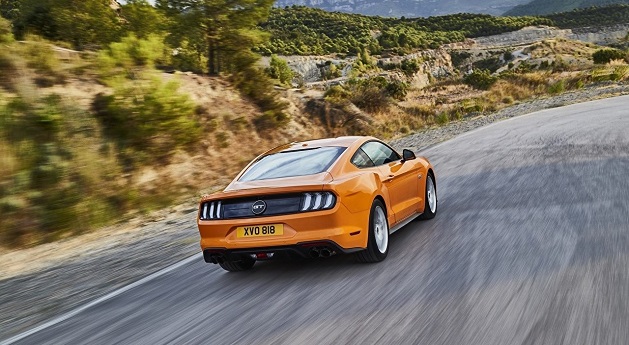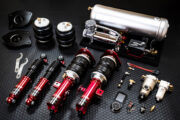Regardless of whether you go with the Ecoboost, GT or Dark Horse variants of the seventh-generation Ford Mustang, you’ll see sub-5-second sprints to 100km/h. Both the turbocharged 2.3-litre and aspirated 5-litre engines are quick to redlines and urged on by snappy six-speed manual or ten-speed auto transmissions. But the Mustang offers a whole lot more than just outright speed. The distinctive styling embodied in the pair of 3 stripe tail lights harking back to the 1964 original, the huge 19-inch cast alloys and Brembo brakes all-round, paired with grippy low-profile tyres, a limited-slip diff, and paddle shifters, equate to a soul-stirring ride. The only thing missing is a decent exhaust to justify all the wild horses under the hood.
Why An Aftermarket Exhaust for Your Mustang?

A deeper, throatier exhaust note and substantial increases in power and torque are what you get with aftermarket exhausts for Mustang. Let’s be clear, no model of the car is lacking in power. But as petrolheads, we want more of everything, and this is where revised exhausts deliver. Wider and straighter tubing fitting in the recesses meant for the stock exhaust helps the engine breathe, by expelling spent gases faster and limiting temperature and pressure buildup. All this translates to more efficient combustion and more overall power. Accompanying the faster exhaust flow is a meatier sound from the tips, increasing in volume the more you work the acceleration pedal.
Besides the faster acceleration, snappier throttle response and higher top speeds with the power gains, Ford Mustang performance exhausts are also meant to last. They’re made of durable materials, have thicker walls, and better handle the higher heat that comes with more horsepower. And they’re less susceptible to denting, rupturing or rusting when the car is curbed and battered through wet roads, potholes and bumps.
Lastly, there’s more attention to fine details, like mounting hardware that reduces vibrations, and a fit and finish that better matches the overall look of the car. Particularly interesting is the selection of tips from different exhaust manufacturer portfolios, so you can customise the car to personal tastes.
Choosing the Right Exhaust
There are quite a few things to consider when buying a new exhaust for your Ford:
Materials and Build
Besides exhausts with aluminised mufflers, most aftermarket systems go for all-round mandrel-bent stainless steel as the least expensive option. This is still miles ahead of the mild steel in the factory pipes made by crush bending, with higher tensile strength and resistance to fatigue and impact. Of course, you can spend a whole lot more for exotic materials like titanium or Inconel, and add carbon-fibre tips to the equation to bump up the wall harness even more and shed a few kilos in the process. You’ll also get better resistance to corrosion and staining.
Sound Profiles
All Mustangs produce a nice tune from the exhaust tips, but owners can add a bit more substance and turn up the volume. This is done with wider straight tubing in different sections, and with a range of muffler and resonator combos that allow for freer airflow. Alternatively, if you find the sound from the stock exhaust a bit too loud for your liking, or are rebuilding an older car and need to meet noise emissions, then opt for ‘quiet’ exhausts for Mustang. These include more insulative materials in the muffler baffles. They prevent droning noises from reaching the cabin, but won’t affect overall performance.
Track-ready Mustangs

Noise and emissions regulations are a major factor in exhaust design. In street cars, parts that reduce overall noise and the amount of toxic gases leaving the tips can also hurt engine performance. If you’re using your car solely for track purposes, then consider parts like high-flow cats or catalytic deletes, and straight-pipe mufflers. Exhausts are modular by design, so you can swap out all parts or those that create airflow restrictions. Just keep in mind state and federal laws as to what’s street legal and what isn’t.
Cat-back, Axle-back, and Header/Turbo-back Systems
How much of the old exhaust you get rid of is proportionate to the expected power gains. So, going with wider, 3-inch dual tubes from the manifold or headers to the tips in what is called a header-back system nails you the best performance. The revised headers and collectors are responsible for most of the added power, by easing airflow and encouraging exhaust scavenging. Estimates are that you get an added 10 to 15 per cent more bhp and torque, so at least 30 more horses in the Ecoboost engine, and up to 50 more with the 5-litre V8. Torque increases by 50Nm in the 4-pot car and close to 75Nm in the bigger engine. To balance out the increase in power, and for smoother power delivery, you’ll also need an ECU-tune to calibrate the fuelling and ignition timing.
Cat-back systems have wider mid-section piping, from the catalytic converter (adding roughly 5 per cent over factory numbers) and can include reworked mufflers for better sound. This attaches to the stock downpipes. And lastly, the cheapest ‘complete’ system and the one most buyers choose are axle-back exhausts. These swap out the factory parts from the rear axle to the exhaust tips, improving exhaust flow and tuning the sound. Which system you choose for your Mustang will be based on your expectations in terms of overall power, and how much you’re willing to spend.


